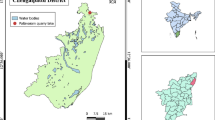Abstract
Studies on nativeBeggiatoa demonstrated diel vertical migration into, and out of, sediments at the bottom of warm spring pools. Laboratory experiments withBeggiatoa in natural sediments suggested that high light was the cause of the downward movement. The nature of this presumed photomotion was clarified by microscopic observation of individual filaments of nativeBeggiatoa at light/dark boundaries where the light was varied in intensity and quality. Using “white light”, a negative photo-response was demonstrated, and a dose-response curve was constructed which indicates an increasing response to light over three orders of magnitude of intensity. A coarse action spectrum implicated a pigment with a peak in the blue region as the receptor. Pure culture studies showed the negative response to be a step-up phobic one. The light intensity increase necessary to invoke reversals was a smaller percentage of the initial intensity for higher initial intensities. The light intensity levels and gradient strengths necessary to evoke reversals in single filaments were consistent with the hypothesis that the step-up response accounts for the disappearance in the field. This response has adaptive significance since full sunlight was completely inhibitory toBeggiatoa growth, even when filaments were aggregated in tufts. Dilute suspensions were also inhibited by as little as 5000 lux (fluorescent lamps).
Similar content being viewed by others
References
Adler J (1975) Chemotaxis in bacteria. Annu Rev Biochem 44:341–356
Blum HF (1941) Photodynamic action and diseases caused by light. Reinhold, New York
Burton SD, Morita RY (1964) Effect of catalase and cultural conditions on growth ofBeggiatoa. J Bacteriol 88:1755–1761
Cannon GC, Strohl WR, Larkin JM, Shively JM (1979) Cytochromes inBeggiatoa alba. Curr Microbiol 2:263–266
Castenholz RW (1968) The behavior ofOscillatoria terebriformis in hot springs. J Phycol 4:132–139
Clayton RK (1953a) Studies in the phototaxis ofRhodospirillum rubrum. I. Action spectrum, growth in green light, and Weber Law adherence. Arch Mikrobiol 19:107–124
Clayton RK (1953b) Studies in the phototaxis ofRhodospirillum rubrum. III. Quantitative relations between stimulus and response. Arch Mikrobiol 19:141–165
Clayton RK (1964) Phototaxis in microorganisms. In: AC Giese (ed) Photophysiology, vol 2. Academic Press, London, pp 51–77
Diehn B, Feinleib ME, Haupt W, Hildebrand E, Lenci F, Nultsch W (1977) Terminology of behavioral responses of motile microorganisms. Photochem Photobiol 26:559–560
Drews G (1959) Beiträge zur Kentnis der phototaktischen Reaktionen der Cyanophyceen. Arch Protistenkd 104:389–430
Epel BL, Butler WL (1970) Inhibition of respiration inPrototheca zopfii by light. Plant Physiol 45:728–734
Epel BL, Krauss RW (1966) The inhibitory effect of light on growth ofPrototheca zopfii Kruger. Biochim Biophys Acta 120:73–83
Gomori G (1955) Preparation of buffers for use in enzyme studies. In: SP Colowick, NO Kaplan (eds) Methods in enzymology, Vol 1. Academic Press, New York, pp 138–146
Gressel J (1979) Blue light photoreception. Photochem Photobiol 30:749–754
Güde H, Strohl WR, Larkin JM (1981) Mixotrophic and heterotrophic growth ofBeggiatoa alba in continuous culture. Arch Microbiol 129:357–360
Halfen LN, Castenholz RW (1971) Gliding motility in the blue-green alga,Oscillatoria princeps. J Phycol 7:133–145
Halliwell B (1979) Oxygen-free radicals in living systems: dangerous but useful? In: M Shilo M (ed) Strategies of life in extreme environments. Verlag Chemie, Weinheim New York, pp 195–221
Harayama S, Iino T (1976) Phototactic response of aerobically cultivatedRhodospirillum rubrum. J Gen Microbiol 94:173–179
Harayama S, Iino T (1977) Ferric ion as photoreceptor of photophobotaxis in non-pigmentedRhodospirillum rubrum. Photochem Photobiol 25:571–578
Hollaender A (1956) Radiation biology. III. Visible and near-visible light. McGraw-Hill, New York
Jørgensen BB (1977) Bacterial sulfate reduction within reduced microniches of oxidized marine sediments. Mar Biol (Berlin) 41:7–17
Kleinig H, Reichenbach H (1977) Carotenoid glucosides and menaquinones from the gliding bacteriumHerpetosiphon giganteus Hp a2. Arch Microbiol 112:307–310
Kowallik U, Pringsheim EG (1966) The oxidation of hydrogen sulfide byBeggiatoa. Am J Bot 53:801–806
Lackey JB (1960) Factors determining habitats of certain sulfur bacteria. Q J Fl Acad Sci 23:214–221
Macnab R, Koshland DE (1974) Bacterial motility and chemotaxis: light-induced tumbling response and visualization of individual flagella. J Mol Biol 84:399–406
Matthews MM, Sistrom WR (1959) Function of carotenoid pigments in nonphotosynthetic bacteria. Nature (London) 184:1892–1893
Metzner P (1919) Über die Wirkung photodynamischer Stoffe aufSpirillum volutans und die Beziehungen der photodynamischen Erscheinung zur Phototaxis. Biochem Z 101:33–53
Moss GP, Weedon BCL (1976) Chemistry of carotenoids. In: TW Goodwin (ed) Chemistry and biochemistry of plant pigments. Academic Press, London Vol 1, pp 149–224
Nelson DC (1979) The biology ofBeggiatoa — organic nutrition, sulfur utilization and light responses. Ph. D. thesis, University of Oregon, Eugene, USA
Nelson DC, Castenholz RW (1981a) The organic nutrition ofBeggiatoa sp. J Bacteriol 147:236–247
Nelson DC, Castenholz RW (1981b) The use of reduced sulfur compounds byBeggiatoa sp. J Bacteriol 147:140–154
Ninnemann H (1980) Blue light photoreceptors. Bioscience 30:166–170
Nultsch W (1970) Photomotion of microorganisms and its interactions with photosynthesis. In: P Halldal (ed) Photobiology of microorganisms. Wiley-Interscience London, pp 213–251
Poff KL, Loomis WF, Butler WL (1974) Isolation and purification of the photoreceptor pigment associated with phototaxis inDictyostelium discoideum. J Biol Chem 249:2164–2167
Richardson J (1964) Physics in botany. Pitman, New York
Sistrom WR (1978) Phototaxis and chemotaxis. In: RK Clayton, WR Sistrom (eds) The photosynthetic bacteria. Plenum Press, New York, pp 899–905
Sokal RR, Rohlf FJ (1969) Biometry. Freeman, San Francisco
Strohl WR, Larkin JM (1978) Enumeration, isolation, and characterization ofBeggiatoa from freshwater sediments. Appl Environ Microbiol 36:755–770
Taylor BL, Koshland DE (1975) Intrinsic and extrinsic light responses ofSalmonella typhimurium andEscherichia coli. J Bacteriol 123:557–569
Winogradsky S (1887) Über Schwefelbakterien. Bot Ztg 45:489–507, 513–523, 529–539, 545–559, 569–576, 585–594, 606–610
Author information
Authors and Affiliations
Rights and permissions
About this article
Cite this article
Nelson, D.C., Castenholz, R.W. Light responses ofBeggiatoa . Arch. Microbiol. 131, 146–155 (1982). https://doi.org/10.1007/BF01053997
Received:
Accepted:
Issue Date:
DOI: https://doi.org/10.1007/BF01053997




